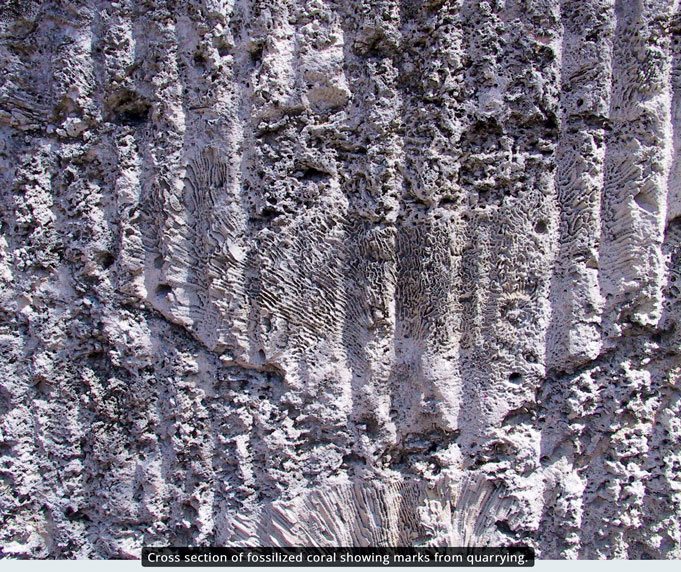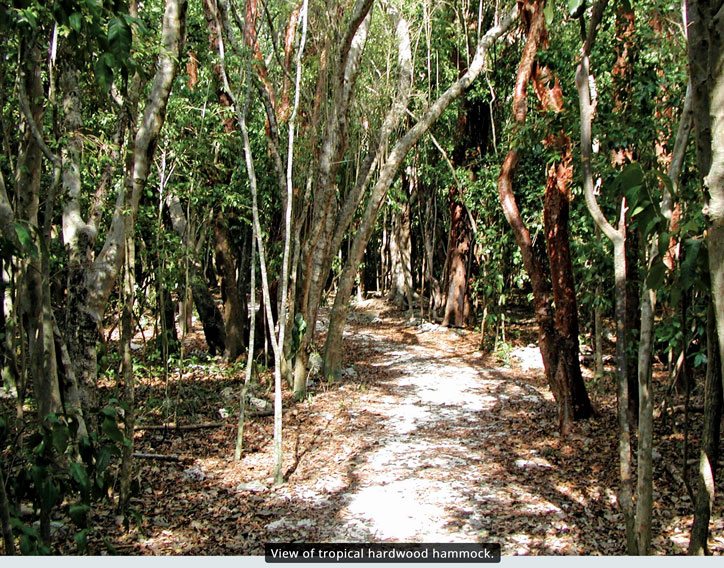
Once upon a time, all of the Florida Keys were under water, and perhaps nowhere is this more evident than at Windley Key Fossil Reef Geological State Park in Islamorada. With fossil remains uncovered by quarry excavations during the 1900s, the state bought 300 acres to prevent development at the historic site and created a park that showcases Florida Keys limestone and its submerged heritage. The park also offers terrific trails through the woods with opportunities to see wildlife while learning about Keys history.
A rock quarry was active at the site until the 1960s, and used equipment remains on site at mile marker 85 with explanatory plaques.
In the last century, Henry Flagler owned the land. His “Oversea Railway” would stop for water there. Flagler purchased Quarry – as it was known – in 1908 from the Russell family who had homesteaded there in 1833. The tycoon paid $856.80 for the land in order to have fill material for his Florida East Coast Railway, which was necessary for the rail bed and bridge approaches that would make its way to Key West.
Today, eight-foot high rock walls left over from quarrying days showcase a variety of coral.

According to a guidebook available to visitors in the park’s Alison Fahrer Environmental Education Center, five coral species can be found in the limestone — and also can be seen in the patch reefs in the ocean off of the Keys. These include boulder star coral, mustard hill coral, finger coral, staghorn coral and brain corals. Because elkhorn coral never has been found in the Key Largo limestone, geologists believe the Upper Keys were once a giant patch reef. Elkhorn coral is found on the outer reefs, according to the researchers.
“Over the centuries, the sea rose and fell,” says the park brochure. “At times, the water level was approximately 25 feet higher than at present, while other times, the ocean level dropped by as much as 300 feet… About 5,000 years ago, the water level stabilized and the ancient coral reef crest that remained exposed created the islands we call the Florida Keys.”
Geology students and geologists are among the 11,000 annual visitors to the park, according to Mike Guarino, park manager.
Evidence of early Native American tribes also were found in the “middens” or mounds of animal bones, pottery shards and shells at Windley Key. The Calusa Indians inhabited the Keys.

The state park, open Thursday through Monday from 9 a.m. to 5 p.m., has one of the highest elevations in the Keys chain – 18 feet. There is about a mile of nature trails, and a few offer inclines, a surprising find in the flat Florida Keys. Park staff encourages visitors to walk all the trails to explore the different habitat and native species. Guests can also bring a picnic and dine at the picnic tables in Flagler Quarry.
In the spring and fall, bird migrations attract bird lovers. On a breezy May morning, a mangrove cuckoo, an uncommon sighting, rested in a tree. Other unique, non-native birds sighted in the park that week were a Bahama mockingbird and Western Spindalis, a colorful songbird.
In summer, blooming species along the trails attract visitors. Among the flowering species are Spanish stopper, white stopper, torchwood, poisonwood, seaside gentian and wild tamarind.
But, in winter, the cooler weather keeps mosquitos at bay and visitors can enjoy history, nature and exercising in a truly unique setting. Children may enjoy making rubbings of the fossils with paper and crayons for an inexpensive memento recalling yesteryear when the Keys were an underwater reef.
For more information, visit floridastateparks.org/park/Windley-Key or call 305-664-2540.




